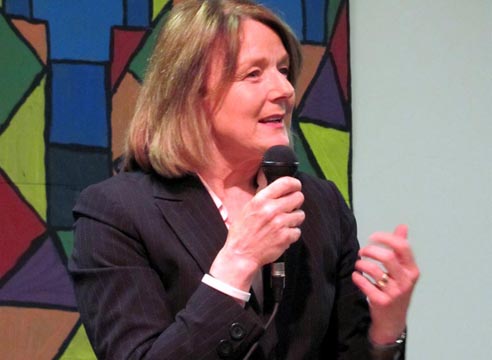Campaigning in her Parkdale-High Park riding in Toronto, Peggy Nash came up the steps to be met by a large man wearing a baseball cap with a beer in his hand. He looked at her: “You’re NDP, aren’t you? Get off my porch, I don’t like the NDP.”
“I can see you are warming to me,” Peggy replied.
The man looked again, laughed, and invited her up for some talk.
The NDP leadership race needs Peggy Nash. She is positive, relaxed, listens to people, expresses herself well in both official languages (and Spanish), and knows how to make change happen.
The current race began with the party president, Brian Topp, declaring quickly. Backed by former leader Ed Broadbent (now heading a party sponsored think-tank) the surprising candidacy of someone outside the caucus was interpreted by insiders as a challenge to Thomas Mulcair, the lone New Democratic MP from Quebec prior to the orange wave of 2011 which elected 59 members. Mulcair is a Quebec favorite son, and likely to run strongly across Canada. He was happy to take on the challenge and had some pointed remarks to make about Topp not being elected.
A polarized contest between two hard-driving candidates is not something party members are likely to appreciate. What a lot of party members want to see is for all candidates to be given a real hearing. Paul Dewar, a highly regarded Ottawa MP, is popular within party ranks, and will run a strong race. Nathan Cullen has an inspiring message to deliver on climate change that will influence every candidate. Romeo Saganash from the Cree nation in northern Quebec is a marvelously exciting candidate. Martin Singh is not widely known outside Nova Scotia, but people will want to hear what he has to say. Yet others may well enter the race.
A Canadian Autoworker, with an honours degree in French Literature, Peggy is highly qualified to lead the party. After the last election, Jack Layton looked at his 102-member caucus and asked Peggy to take on the important role of Finance critic for the Loyal Opposition. Peggy Nash would bring a much needed focus on economic issues to the race.
In 2008, Jack asked her to run for party president: she did, and she won. Peggy supported Jack Layton in his successful leadership bid. In 2004, at Jack’s request, Peggy first ran for parliament; and she was a big part of his team in the last four general elections.
An important task facing the next leader will be building the party. In my last substantive conversation with Jack Layton, he said the party needed a million members.
The $2 per vote subsidy, used by the NDP to build its organizational strength going into the last election, disappears after the 2015 election. Jack saw the need to reach out to union memberships, using the political tax credit (give the party $125, and get yourself credit against federal income tax of $100) to build the party base across Canada.
Peggy Nash is an activist, widely known within the trade union movement. Through speeches and her presence at regular union conventions, she has what it takes to build the party membership among union activists.
It is not enough to bring in union support; the party has to keep that support through acting on behalf of working people. Peggy is someone people can trust on the issues. She has been working to improve people’s lives in her entire career in the union movement.
The party needs an activist as leader. When the NDP has gotten into trouble with its membership, it was because the leader failed to listen to what its activist members were saying. This happened when the party ran its weak national campaign against free trade in 1988 (not in B.C., where it won 19 seats opposing the deal), when it focused on the reducing the deficit in the midst of the great recession of 1982, or when it agreed to a constitutional package proposed by the Trudeau government without consulting the party, or even its provincial leaders.
The winner of the leadership becomes Leader of the Loyal Opposition (LLO) which brings with it an important role in parliament, and the country. Seated across from the prime minister, the position of the LLO is recognized under the unwritten part of our constitution. The incumbent gets an official residence, and has a status equivalent to a cabinet minister. When a head of state or government visits Canada, they normally meet with the LLO.
For the first time, there is more at stake in a leadership race than becoming leader of the third or fourth party. To reduce any bitterness following the outcome, it is important that the membership have a wide choice of candidates. The outcome should be decided by what each candidate has to offer.
When Peggy came off the porch from her polite exchange with Mr. I-don’t-like-the-NDP, I can hear her saying to her campaign workers as you goes off down the street: “next time he takes a sign.”
Duncan Cameron is rabble.ca’s president and writes a weekly column on politics and current affairs.



